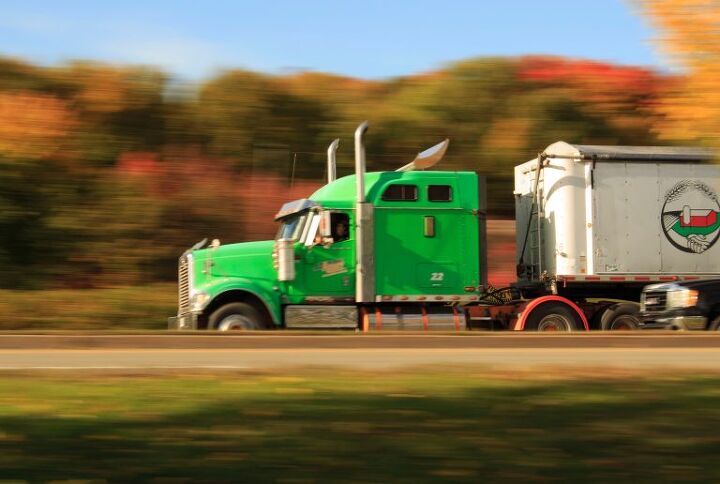EPA to Resume Enforcement of 'Glider Truck' Rules

The new acting administrator of the Environmental Protection Agency, Andrew Wheeler, has jackknifed former EPA head Scott Pruitt’s decision to quit enforcing the strict sales limits imposed on glider trucks.
If you’re unfamiliar with the term, they’re basically new heavy commercial trucks that use old powertrains. Advocates argue that using refurbished engines and transmissions save business owners loads of cash and promote recycling, since the internals would likely end up in a scrapyard. However, many complain that glider trucks simply exist to circumvent emissions regulations.
During President Obama’s tenure, the EPA said that if gliders were allowed through 2025, they would make up a scant five percent of the freight vehicles on the road — but would account for one third of all nitrogen oxides and particulate emissions from the heavy truck fleet. A crackdown was inevitable.
However, the EPA under President Donald Trump said gliders should not be regulated as new motor vehicles under the Clean Air Act. In 2017, Pruitt claimed prohibiting their sales risked putting specialized truck manufacturers out of business as he moved toward deregulation.
In fact, the EPA later issued a “no action assurance” letter on July 6th (Pruitt’s last day) that said glider truck firms would not have to limit their annual production to 300 vehicles through the end of 2019.
Wheeler performed an about-face on the issue, saying he has “concluded that the application of current regulations to the glider industry does not represent the kind of extremely unusual circumstances that support the EPA’s exercise of enforcement discretion.”
According to the LA Times, environmental groups challenged the EPA’s “no action assurance” letter on July 17th in the U.S. Court of Appeals for the District of Columbia Circuit, asking for an administrative stay as the court considered their emergency motion. That motion was granted the following day.
New Jersey Attorney General Gurbir S. Grewal said the July 6th memo “was blatantly unlawful … By letting more of these super polluting trucks on the road, EPA is putting politics before the public’s health and safety.”
On Thursday, Wheeler said the EPA will move expeditiously on revising the regulations “that apply to the introduction of glider vehicles into commerce to the extent consistent with statutory requirements and due consideration of air quality impacts.” The agency later confirmed it had withdrawn the guidance established under Pruitt.

A staunch consumer advocate tracking industry trends and regulation. Before joining TTAC, Matt spent a decade working for marketing and research firms based in NYC. Clients included several of the world’s largest automakers, global tire brands, and aftermarket part suppliers. Dissatisfied with the corporate world and resentful of having to wear suits everyday, he pivoted to writing about cars. Since then, that man has become an ardent supporter of the right-to-repair movement, been interviewed on the auto industry by national radio broadcasts, driven more rental cars than anyone ever should, participated in amateur rallying events, and received the requisite minimum training as sanctioned by the SCCA. Handy with a wrench, Matt grew up surrounded by Detroit auto workers and managed to get a pizza delivery job before he was legally eligible. He later found himself driving box trucks through Manhattan, guaranteeing future sympathy for actual truckers. He continues to conduct research pertaining to the automotive sector as an independent contractor and has since moved back to his native Michigan, closer to where the cars are born. A contrarian, Matt claims to prefer understeer — stating that front and all-wheel drive vehicles cater best to his driving style.
More by Matt Posky
Latest Car Reviews
Read moreLatest Product Reviews
Read moreRecent Comments
- MaintenanceCosts So this is really just a restyled VW Fox. Craptacular tin can but fun to drive in a "makes ordinary traffic seem like a NASCAR race" kind of way.
- THX1136 While reading the article a thought crossed my mind. Does Mexico have a fairly good charging infrastructure in place? Knowing that it is a bit poorer economy than the US relatively speaking, that thought along with who's buying came to mind.
- Lou_BC Maybe if I ever buy a new car or CUV
- Lou_BC How about telling China and Mexico, we'll accept 1 EV for every illegal you take off our hands ;)
- Analoggrotto The original Tassos was likely conceived in one of these.

































Comments
Join the conversation
300 dirty engines per year per co. does not seem like a lot. Then again, these could be melted for something new or not produced and air would be cleaner. Can't this tiny industry build kits which would allow more flexibility with modern engine/tractor combos? Second hand Tier-4 engines to new chassis or something so at least some people could keep their jobs.
The glider sales dynamic has changed. Before, if you crashed your newer rig and repairs exceeded the value, a glider could be built off your original build sheet matching all your heavy components. You got a fully built-out cab, hood, frame, front suspension, and front axle. Your wrecked doner supplied the powertrain including the rear axle and suspension. Rebuild labor was minimized and you were back on the road weeks sooner at lower cost. Today it seems glider-built trucks feature much older salvage engines and drivetrains as the big selling point. Limit salvage engines to three years old and newer and the glider market is right side up again. If it is your crashed truck being kitted, make it five years. CarPerson